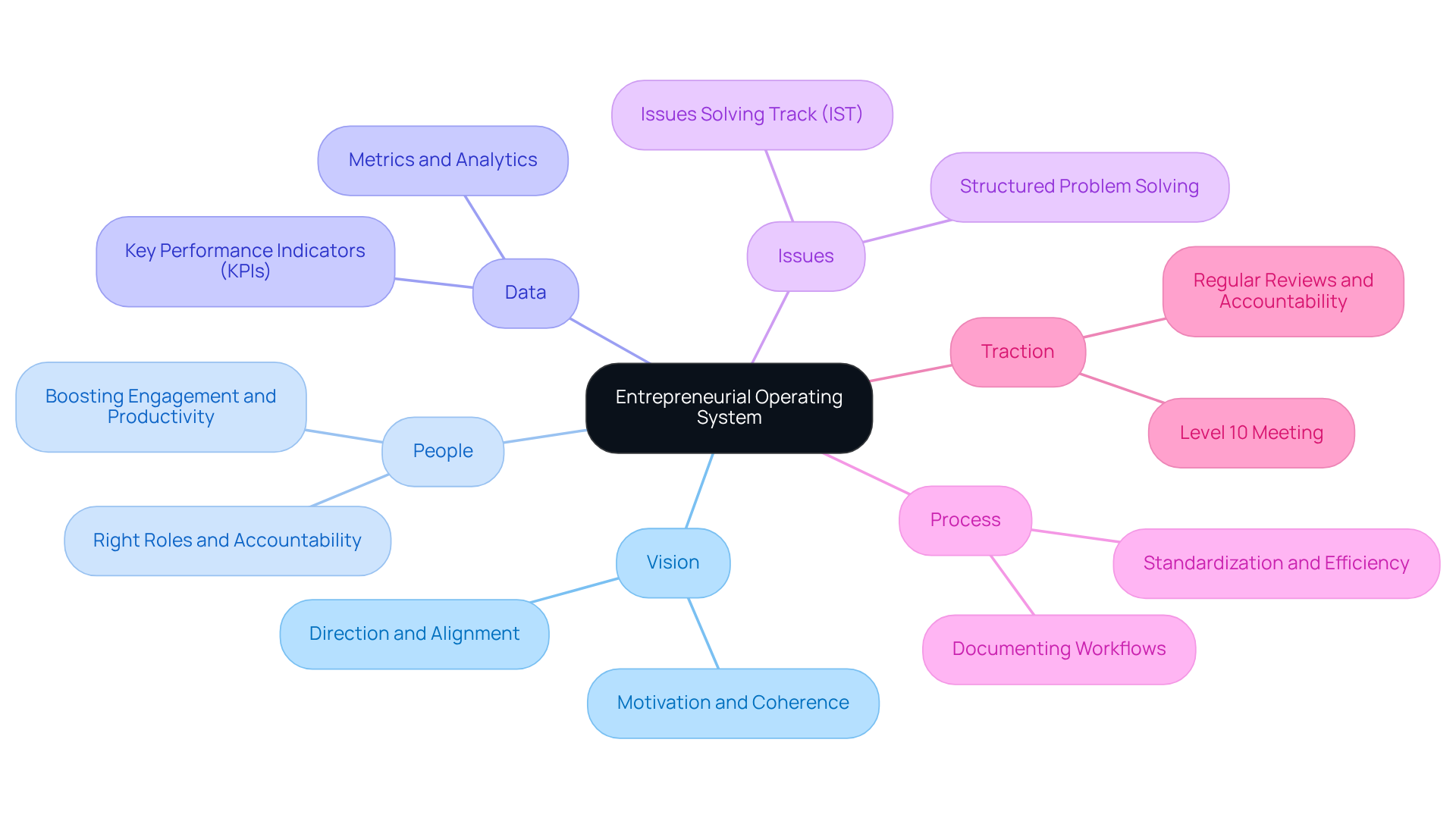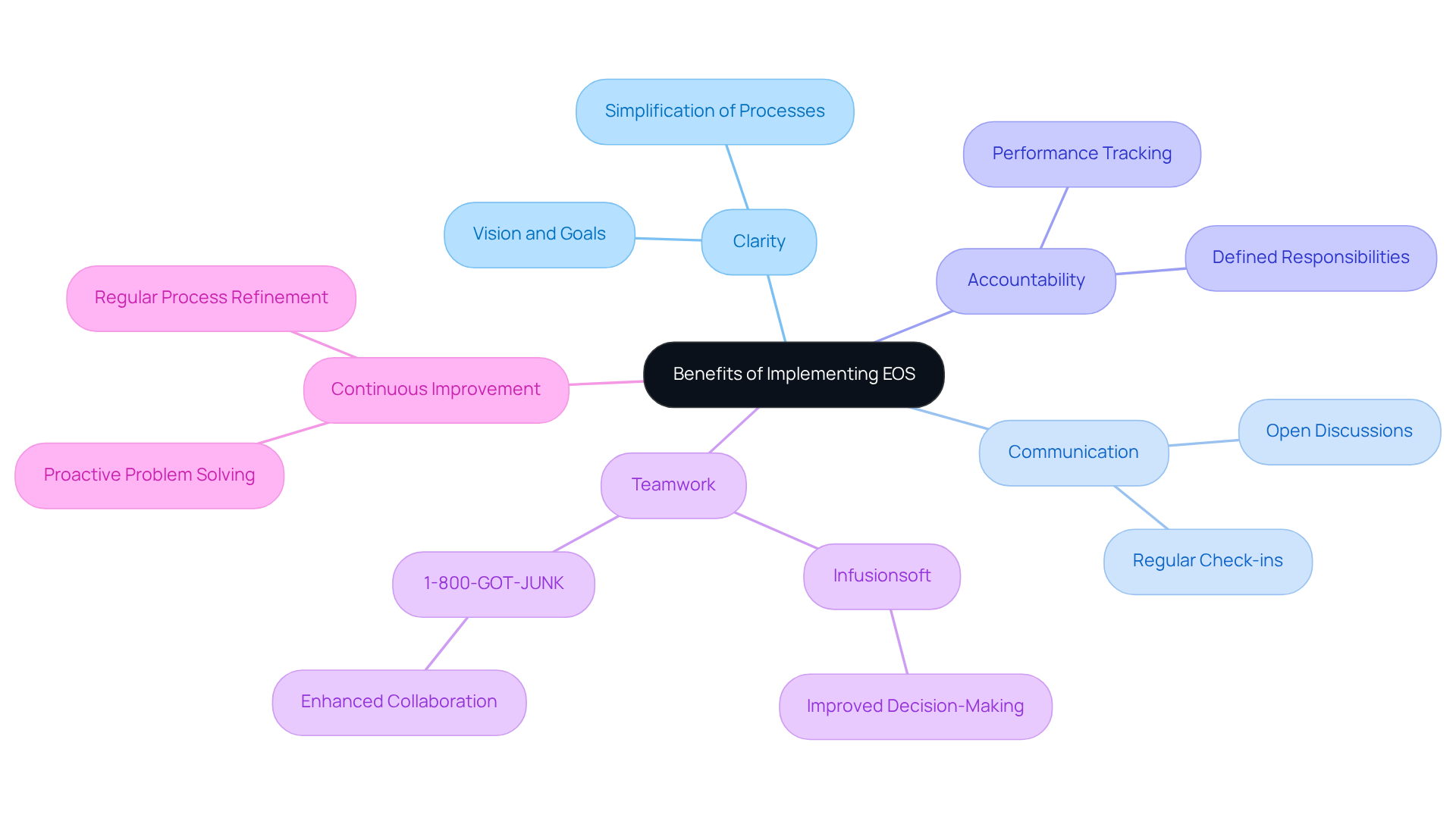
Maintaining Up-to-Date Documentation
|
October 17, 2025
|
Understanding the Entrepreneurial Operating System Definition
Overview
You might be wondering what the Entrepreneurial Operating System (EOS) is all about. Well, it's a comprehensive framework designed to help businesses like yours hit those big goals using actionable tools and principles. EOS focuses on six key components:
- Vision
- People
- Data
- Issues
- Process
- Traction
Now, here’s the exciting part—over 257,000 companies have successfully implemented EOS and reported significant boosts in profitability and productivity. This just goes to show how effective EOS can be in enhancing communication, accountability, and operational efficiency. So, if you're looking to elevate your business, EOS might just be the solution you need!
Key Highlights:
- EOS is a framework designed to help businesses achieve goals through actionable tools and principles.
- The six key components of EOS are Vision, People, Data, Issues, Process, and Traction.
- Over 257,000 companies have successfully implemented EOS, reporting a 23% increase in profitability and an 18% boost in productivity.
- EOS enhances communication, clarifies roles, and fosters a culture of accountability within teams.
- The Level 10 Meeting is a structured method within EOS for addressing important issues and maintaining accountability.
- SowFlow offers a dynamic approach to documentation that supports the EOS framework by clarifying responsibilities and enhancing efficiency.
- The evolution of EOS has allowed it to adapt to various industries, promoting organised and focused business operations.
- Companies like Infusionsoft and 1-800-GOT-JUNK have successfully integrated EOS, leading to improved decision-making and teamwork.
- EOS promotes accountability, ensuring team members understand their roles and responsibilities, which boosts morale and efficiency.
- EOS has helped over 100,000 businesses worldwide achieve clarity and operational success.
Introduction
You might be wondering why understanding the entrepreneurial operating system (EOS) is so crucial for businesses aiming to grow and thrive in today’s competitive world. Well, this structured framework does wonders by helping organizations clarify their vision and align their teams. Plus, it nurtures a culture of accountability and continuous improvement.
Now, with so many businesses jumping on the EOS bandwagon, what really makes it stand out? And how can you use it to see real results? Let’s dive into the fascinating details of EOS and uncover the key components that drive operational excellence.
Defining the Entrepreneurial Operating System (EOS)
You might be wondering about and how it can really help your business. Well, it’s a solid framework designed to empower companies like yours to hit those big goals using simple, actionable tools and principles. By bringing together six key components—Vision, People, Data, Issues, Process, and Traction—EOS makes management and operations a breeze. This organized approach helps teams turn their vision into real actions, creating a culture of accountability and alignment among members.
But EOS isn’t just some theory floating around; it’s been successfully put into action by over 257,000 companies worldwide. That’s a lot of businesses seeing real benefits! For example, those who embrace EOS often report a 23% increase in profitability and an 18% boost in productivity, according to Gallup's research. And get this—Gallup also found an 81% difference in absenteeism between teams in the top and bottom quartiles, highlighting just how crucial employee engagement is when it comes to implementing EOS.
You can really see the framework's practical benefits in how it enhances communication, clarifies roles, and prioritizes goals. This all leads to a more cohesive and efficient work environment. Leaders who adopt EOS frequently rave about its transformative impact, emphasizing that the goal is to reach 80% or higher in performance. This dedication to continuous improvement and structured goal-setting aligns with the entrepreneurial operating system definition, making it an essential tool for companies aiming for sustainable growth and better operational efficiency.
A key part of EOS is the Level 10 Meeting, which gives teams a structured way to tackle important issues and keep everyone accountable. Plus, setting and achieving 'Rocks' every 90 days helps groups stay focused and drive results. As Gino Wickman puts it, 'Anything that is measured and watched is improved.' This really drives home the importance of performance metrics in achieving operational excellence.
The Evolution and Context of EOS in Business
You might be wondering about and how it became such a game-changer for businesses today. Well, it all started with Gino Wickman in his influential book 'Traction'. He laid the groundwork for what is now known as the entrepreneurial operating system definition, which has since adapted based on feedback from various industries. This flexibility has allowed EOS to refine its tools and principles, catering to the unique needs of businesses across different sectors.
Now, let’s dive into how business management has evolved over the last decade. There’s been a noticeable shift towards integrated solutions that boost operational efficiency and foster teamwork. As Wickman points out, the entrepreneurial operating system definition has evolved to assist businesses in becoming more organized and focused, ultimately driving better results and growth.
Speaking of growth, have you heard about SowFlow? Their innovative approach to systematic documentation is a real game-changer. Instead of viewing documentation as a one-off task, they treat it as a dynamic system. This means businesses can keep their information up to date, which is super helpful for supporting the EOS framework. Plus, by clarifying document responsibilities and ownership, SowFlow not only streamlines processes but also enhances scalability and efficiency. This makes it a must-have for operations managers looking for structured frameworks to navigate today’s complex business landscape.
Key Components of the Entrepreneurial Operating System
You might be wondering about the entrepreneurial operating system definition and what makes it tick. Well, it’s all about six essential components: Vision, People, Data, Issues, Process, and Traction. Each of these plays a vital role in keeping your business running smoothly and effectively.
Let’s start with Vision. This component sets a clear direction for your organization, helping everyone align towards common goals. A well-defined vision doesn’t just motivate your team; it also brings coherence, which can lead to better performance.
Now, onto People. Getting the right folks in the right roles is key to building a culture of accountability and collaboration. When businesses prioritize this, they often see a significant boost in employee engagement and productivity, as everyone gets to contribute their best.
Then there’s Data. Focusing on metrics and analytics is crucial for making informed decisions and tracking your progress. Companies that keep an eye on 5 to 15 key performance indicators (KPIs) can better understand their performance and make the necessary tweaks to drive efficiency.
Speaking of challenges, let’s talk about Issues. This component gives you a structured way to identify and tackle problems that might slow you down. With the Issues Solving Track (IST) in EOS, teams can systematically address hurdles, improving group dynamics and decision-making.
Next up is Process. Documenting and standardizing workflows is essential for boosting efficiency and consistency. Organizations that have clear processes in place can cut down on chaos, creating a structured environment where employees can really thrive. With tools like SowFlow, teams can easily create and update user guides, keeping documentation relevant and accessible, which streamlines process standardization and knowledge sharing.
Finally, let’s not forget about Traction. Staying focused on your goals through regular reviews and accountability measures is super important. The Level 10 Meeting, which is a structured 90-minute session, shows how teams can enhance productivity and effectiveness by consistently tracking progress and addressing key issues.
When you put all these components together, you create a cohesive system that aligns with the entrepreneurial operating system definition, empowering your business to operate effectively and reach its goals. For example, a small digital marketing agency that adopted EOS saw improved client satisfaction and increased revenues, proving the real benefits of a well-structured operational framework. So, what do you think? Ready to explore how EOS can work for you?

Benefits of Implementing the Entrepreneurial Operating System
You might be wondering how the entrepreneurial operating system definition can really make a difference when applied. Well, let me tell you—it brings some pretty amazing benefits! Think greater clarity, better communication, and heightened accountability across the board. Businesses that jump on the EOS train often find that their teams become more cohesive. Everyone starts to really understand their roles and how they fit into the company’s vision. And that alignment? It’s key for building a culture of continuous improvement, where folks are encouraged to tackle issues head-on and refine processes regularly.
Take companies like Infusionsoft and 1-800-GOT-JUNK, for example. They’ve seamlessly woven EOS into their operations, leading to impressive growth and efficiency. Infusionsoft has used EOS principles to make decision-making a breeze, allowing them to respond more nimbly to market challenges. On the flip side, 1-800-GOT-JUNK has seen a boost in teamwork, which has been essential for overcoming operational hurdles effectively.
Now, let’s talk accountability. EOS promotes a systematic approach, making sure everyone knows their responsibilities and is held accountable for their results. This focus on accountability doesn’t just check boxes—it actually lifts morale and ramps up efficiency, as teams rally around the entrepreneurial operating system definition that emphasizes collaboration towards shared goals. By creating a space where open discussions about challenges are welcomed, EOS helps organizations stay laser-focused on their objectives, paving the way for sustainable success. And here’s a fun fact: EOS has assisted over 100,000 businesses worldwide in achieving clarity, accountability, and operational success. That really shows how effective it can be in !

Conclusion
You might be wondering about the entrepreneurial operating system (EOS) and how it can really make a difference for your business. Well, it’s a fantastic framework that helps companies hit their goals with a structured approach. By bringing together six key components—Vision, People, Data, Issues, Process, and Traction—EOS not only streamlines management but also builds a culture of accountability. This all-in-one system clears up the organizational direction and boosts communication and collaboration, which is essential for sustainable growth.
Throughout this article, we've highlighted some pretty cool insights about the practical benefits of using EOS. Companies that have jumped on board with this framework are seeing some impressive gains in profitability, productivity, and employee engagement. Have you heard about the Level 10 Meeting and the idea of setting 'Rocks' every 90 days? These tools are crucial for keeping teams focused and accountable, allowing them to tackle challenges and track their progress effectively. Plus, the evolution of EOS, shaped by real-world feedback, shows just how adaptable and relevant it is across different industries.
In today’s competitive business world, embracing the entrepreneurial operating system could be a true game-changer for you. By focusing on clarity, accountability, and continuous improvement, organizations can boost their operational efficiency and foster a vibrant workplace culture. So, if you’re looking to take your performance to the next level and achieve long-term success, exploring the EOS framework is definitely a smart move toward unlocking your full potential.
Frequently Asked Questions
What is the Entrepreneurial Operating System (EOS)?
The Entrepreneurial Operating System (EOS) is a framework designed to help companies achieve their goals using simple, actionable tools and principles. It integrates six key components: Vision, People, Data, Issues, Process, and Traction, to streamline management and operations.
How does EOS benefit businesses?
EOS has been implemented by over 257,000 companies worldwide, leading to significant benefits such as a reported 23% increase in profitability and an 18% boost in productivity. It also enhances communication, clarifies roles, and prioritizes goals, contributing to a more cohesive and efficient work environment.
What role does employee engagement play in EOS?
Employee engagement is crucial to the successful implementation of EOS. Research by Gallup shows an 81% difference in absenteeism between teams in the top and bottom quartiles, highlighting the importance of engaged employees in achieving operational excellence.
What is the Level 10 Meeting in EOS?
The Level 10 Meeting is a structured approach within EOS that helps teams address important issues and maintain accountability. It provides a regular forum for discussing progress and challenges, ensuring everyone stays aligned with the company's goals.
What are 'Rocks' in the context of EOS?
'Rocks' refer to specific, measurable goals that teams set to achieve every 90 days. This practice helps groups maintain focus and drive results, reinforcing the importance of performance metrics in improving operational efficiency.
What is the goal of implementing EOS?
The primary goal of implementing EOS is to achieve a performance level of 80% or higher, fostering a culture of continuous improvement and structured goal-setting to enable sustainable growth and better operational efficiency.
👍
What others are liking
5 Steps to outline your ideal documentation structure
5 MINS READ
Where to start the your journey of mapping out your ideal documentation structure, aligning it with the very heartbeat of your organization?
Defining a winning level of detail in your process
3 MINS READ
What is too much detail, and what is too little? This article described in that winning level detail about what detail is enough.





